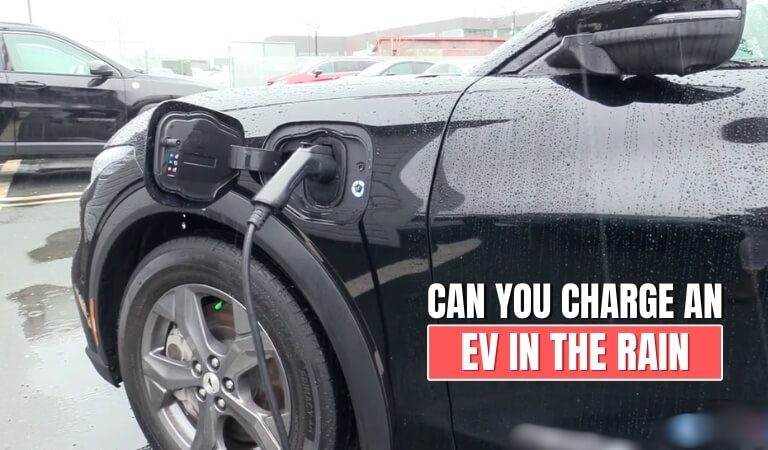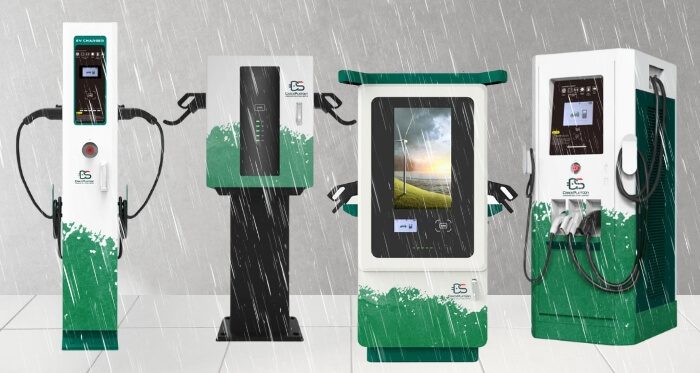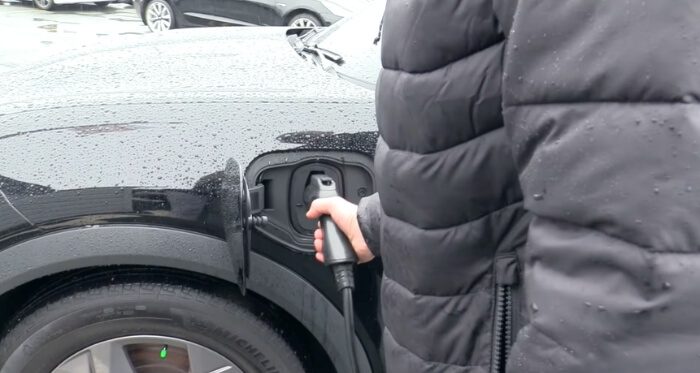Many EV owners wonder about charging their vehicles in the rain. Pure distilled water isn’t an electric conductor, but when the metals and ions dissolve in water, electricity flows within it. So, EV owners pondering the question ‘Can you charge an EV in the rain?
Yes, you can. The EVs and their chargers are designed as waterproof. They are also being tested very precisely for extreme weather situations. The chargers consist of appropriate seals and covers to protect them from moisture.
Especially the chargers from CrackPlatoon CSL are tested waterproof and dustproof equivalent to IP54 standards. It’s great news for Bangladeshi EV users. Here, we’ll explain all the related facts and factors to this query for a clearer and better understanding of the topic. So, keep reading to learn more.
Overview of EV Charging
EV charging is the process of refiling the battery of an electric vehicle by transferring energy from an external source. The charging infrastructure varies in type, ranging from slow, home-based charging units to rapid chargers at public stations. Charging time depends on the vehicle’s battery capacity and the charger’s power output.
Home chargers usually provide slower charging speeds, ideal for overnight use, while public chargers offer faster speeds, suitable for quickly topping up the battery during longer journeys. The compatibility of EV chargers with different vehicles can vary, necessitating adapters or specific EV charging stations for certain models.
The development of EV charging technology aims to increase efficiency, reduce charging times, and expand accessibility to accommodate the growing number of EVs on the road.
Can you Charge an EV in the Rain?
Yes, you can charge an electric vehicle (EV) in the rain. This is a common concern, but modern EV charging technology is designed with safety in mind, ensuring that charging in wet conditions is as safe as in dry ones.

The IP standard defines the protection level for both water and dust. Before using the EV chargers checking the standard is essential for EV users. Most chargers have the labels for their IP testing result.
Manufacturers have implemented these protective measures to prevent any electrical hazards. If somehow the water gets into the EV charger, it will stop and no damage will occur to the EV or the passengers.
These are designed to withstand extreme weather conditions. So, Can you charge an EV in the rain? Yes, it is perfectly safe to charge an EV during a rainy day in Bangladesh, or anywhere else. Here is a breakdown of the different aspects related to the topic.
Weatherproof Equipment
EV charging stations, especially in countries like Bangladesh, are equipped with weatherproofing features. These protect the electrical components from rainwater. The connectors and cables are also designed to withstand water exposure, ensuring safe charging in various weather conditions.
Electrical Safety Standards
All EV charging equipment must meet strict electrical safety standards. These standards are in place to prevent short circuits and electrical shocks, which are essential for safe operation in wet conditions. EV charging stations in Bangladesh are regularly inspected and maintained to ensure they adhere to these safety norms.
User Safety Features
Modern EV chargers come with built-in safety features like ground fault circuit interrupters (GFCIs). These features automatically cut off power in case of any fault, greatly reducing the risk of electric shock. They often include additional safety instructions for users to follow during adverse weather conditions.
By understanding these factors, EV owners in Bangladesh and elsewhere can feel confident and safe when charging their vehicles, even during rainy weather.
The Weatherproof EV chargers from CrackPlatoon in Bangladesh
Crackplatoon Csl EV charging has four different EV chargers. All models MIHIR52, RUMI71, AMITI21, and ALAK48 have safety standards equivalent to IP54. IP stands for Ingress Protection. It’s a standard that defines the ability to stand against extreme weather conditions.

The first number just after IP represents soil or solid or dust protection and the second number represents water protection. The range for dust protection is 0-6 and for water protection 0-9. While 0 represents no protection at all, with the increase of the numbers simultaneously the protection level also increases.
As we mentioned, CrackPlatoon’s EV charger has a protection level of IP54, so they have a rating of 5 out of 6 for dust protection and a rating of 4 out of 9 for water protection. Here are some key features of their EV chargers model.
RUMI71-DC Type Charging Stations from CrackPlatoon
- Robust sheet metal body with a double outlet.
- Weight ranging from 400 to 500 Kg for stability.
- Dimensions: 1886mm x 860mm x 885mm.
- Ample 4.2m cable length.
- High input voltage capacity: 400VAC.
- Double charging socket including CCS and CHAdeMO.
- Output voltage for CCS2 (150-1000V) and CHAdeMO (150-500V).
- Impressive output rating of 142 kWh.
- 5” LCD touchscreen with an emergency stop button and LED indicators.
- RFID functionality for enhanced security.
- Comprehensive protection features include overvoltage, over-current, leakage, under-voltage, overload, short-circuit, grounding, high-temperature, low-temperature, and lightning protection.
- Forced air cooling system for efficient operation.
- Real-time fault monitoring capabilities.
- Anti-UV protection for durability.
- Ethernet, Wi-Fi, and 4G support for seamless communication.
- Humanized operations system for versatile use.
- Compatibility with various mobile payment methods.
- Strong applicability, suitable for major EV models.
- Ideal for offices, malls, charging stations, and industrial parks.
- Dustproof, waterproof design with IP54 and IK10 protection ratings.
- Suitable for commercial squares, office buildings, and more.
AMITI21-AC Type Charging Stations from CrackPlatoon
- The body is made of durable ABS material.
- Single outlet design for user convenience.
- Lightweight at 3 Kg (excluding the cable).
- Compact dimensions: 350mm x 196mm x 150mm.
- Generous 4.2m cable length.
- Input voltage capacity: 230VAC.
- Single charging socket for simplicity.
- Output rating: 400 VAC for single-phase and 22kWh for three-phase.
- Easy installation at various locations.
- Real-time fault monitoring for remote diagnosis.
- User-friendly with a humanized operations system.
- Supports multiple mobile payment methods.
- Comprehensive electric pattern for user convenience.
- 5” LCD touchscreen with emergency stop button and LED indicators.
- RFID functionality for secure access.
- Ethernet network interface for communication.
- Quality assured with TUV and CE certificates.
- Suitable for offices, shopping malls, charging stations, and family garages.
MIHIR52-AC Type Charging Stations from CrackPlatoon
- Sturdy sheet metal body with single and double outlets.
- Substantial weight of 53 Kg (excluding the cable).
- Dimensions: 1630mm x 280mm x 400mm (H x W x D).
- Ample 4.2m cable length.
- Input voltage capacity: 230VAC (single-phase) and 400VAC (three-phase).
- Output current: 32 amp and 7-11kWh (single-phase) and 63 amp, 22-43kWh (three-phase).
- Easy installation in various locations.
- Real-time fault monitoring for remote diagnostics.
- Humanized operations system for user-friendliness.
- Support for multiple mobile payment methods.
- Comprehensive electric pattern for ease of use.
- 5” LCD touchscreen with emergency stop button and LED indicators.
- RFID functionality for added security.
- Ethernet network interface for communication.
- Suitable for various EV models in offices, malls, charging stations, and industrial parks.
ALAK48-AC Type Charging Stations from CrackPlatoon
- Sturdy aluminum alloy body with a single outlet.
- Lightweight at 5 Kg (excluding the cable).
- Compact dimensions: 375mm x 260mm x 104mm.
- Ample 4.2m cable length.
- Input voltage capacity: 230VAC (single-phase).
- Single charging socket for convenience.
- Output rating: 400 VAC for single-phase (7kWh) and three-phase (22kWh).
- 5” LCD touchscreen with emergency stop button and LED indicators.
- RFID functionality for added security.
- Comprehensive protection features: overvoltage, over-current, and leakage protection.
- Natural cooling system for efficient operation.
- Real-time fault monitor for diagnostics.
- Anti-UV protection for durability.
- Ethernet network interface for seamless communication.
- Humanized operations system for versatile use.
- Support for various mobile payment methods.
- Strong applicability, suitable for major EV models.
- Ideal for offices, malls, charging stations, and industrial parks.
What to Do During EV Charging in the Rain?
It might raise some concerns while charging EVs in the rain but with the right precautions, it’s quite safe and straightforward. This is particularly relevant in places like Bangladesh, where monsoon rains are common. Here are some key actions to consider when charging your EV during rainy conditions.

Stay Dry and Alert
During the charging process, ensure you’re standing on a dry surface to minimize any risk of electrical hazards. It’s wise to wear rubber-soled shoes for additional insulation. Even in Bangladesh, where EV charging infrastructure is growing, personal safety should always be a priority.
Check for Any Damage
Before initiating charging, check for any loose or damaged conditions of the EV chargers. Ask the CPO(Charging Point Operator) about the damaged condition of the charger. They always keep the charger condition well and good but still, it’s just precautionary action for being on the safe side.
Use Weather-Protected Equipment
Check for the protective roof above the EV charging station, especially in regions like Bangladesh where sudden downpours are common. It is in the guideline of EVCG(Electric Vehicle Charging Guideline) to have safe and secure conditions for public EV charging stations in Bangladesh.
This not only protects you but also adds an extra layer of safety for the charging equipment. EV charging in Bangladesh often features such weather-adaptive facilities. Because it is recommended by the policy of the EVCG, the Govt. body for EV charging stations in Bangladesh.
Follow Safety Protocols
Always follow the safety instructions provided at the EV charging station. They are there to ensure a safe and efficient charging experience, especially under challenging weather conditions. EV charging stations in Bangladesh come with clear guidelines to assist users during rainy weather.
By following these simple yet effective steps, you can ensure a safe and hassle-free experience when charging your EV, even during the rainy season in Bangladesh.
The Government Regulations and Safety Standards for EV Charging in Bangladesh
The emergence of electric vehicles (EVs) has prompted the government to establish specific regulations and safety standards for EV charging in Bangladesh. These regulations are designed to ensure both user safety and environmental sustainability. Here’s a summary of these key government directives.
- Installation Regulations: Charging stations in Bangladesh must be installed by certified professionals to ensure proper safety and operational standards.
- Regular Inspections: EV charging stations are subject to periodic inspections by government bodies to maintain compliance with safety norms.
- Electrical Safety: The electrical safety provisions of EV Charging Stations shall follow the IEC 61851-1:2017, IEC 61851-23:2014, EC 61851-24:2014, and ISO 17409:2020 standards.
- Quality Standards for Equipment: All EV charging equipment shall have a degree of protection of at least IP54 to ensure reliability and reduce risks of electrical hazards.
- Public Accessibility: Government mandates require a certain percentage of EV charging stations to be publicly accessible to encourage EV adoption.
- Environmental Compliance: Charging stations must adhere to environmental regulations, reducing any negative impact on Bangladesh’s ecosystem.
- User Safety Protocols: Clear safety instructions and emergency procedures must be displayed at all EV charging stations.
- Renewable Energy Incentives: The government encourages the use of renewable energy sources for EV charging through various incentives and subsidies.
These regulations reflect Bangladesh’s commitment to fostering a safe and sustainable environment for the growing EV market.
Final Thought
The safety concern related to charging an EV in the rain has been described briefly. While there are concerns related to the issue, it is good to know that you can charge an EV in the Rain. Because most chargers are designed with the minimum safety standards.
These designs have been tested and certified to withstand these extreme weather conditions. Crackplatoon CSL EV charging models have IP54 level of safety standards making them ideal for rainy conditions. Fulfilling the safety standards condition of Govt. policy. Also, they are leading EV charger suppliers in Bangladesh.
We have emphasized what to do during EV charging in the rain, outlined by the Govt. regulations and safety standards for EV charging stations in Bangladesh. The question “Can you charge an EV in the rain?” has a connection with these factors.
So, while charging your EV in the rain keep these aspects in mind for safe and reliable EV charging. Enjoy your EV journey!
